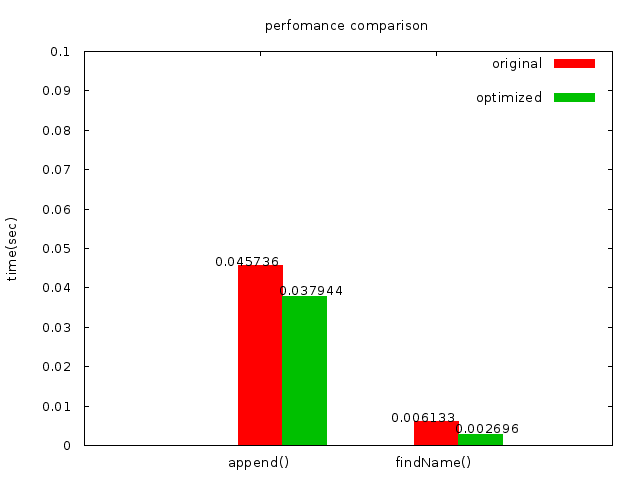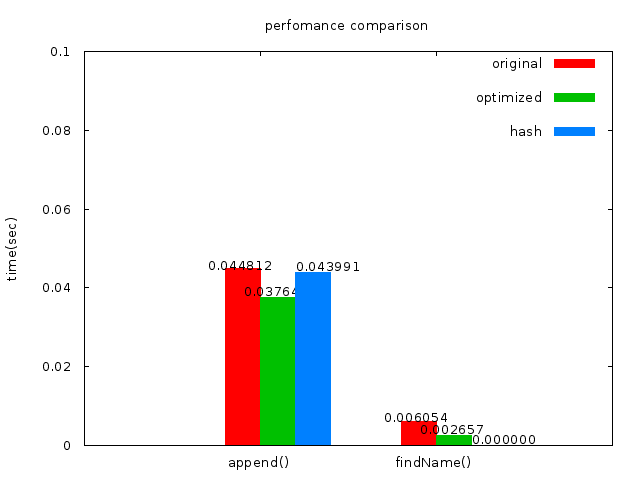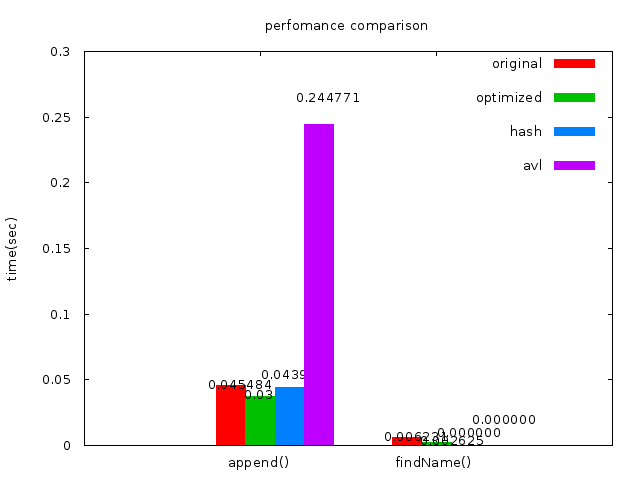# [2016q1 Homework #1](http://wiki.csie.ncku.edu.tw/embedded/2016q1h1)
## 預期目標
* 準備 GNU/Linux 開發工具
* 學習使用 Git 與 GitHub
* 學習效能分析工具
* 研究軟體最佳化
**lscpu | grep cache**
* L1d cache: 32K
* L1i cache: 32K
* L2 cache: 256K
* L3 cache: 6144K
## 實作的優化方法
**改善資料結構**
1.修改structure結構,使得structure裡頭只有lastName實際佔空間,由於原本的structure太大所以一個cache沒辦法放入很多結構所以改小structure
**改善搜尋演算法**
2.HASH
3.BST
4.AVL Tree
**修改Makefile與scripts/runtime.gp**
[參考](https://xn--[]-fs3g/#ifndef, #define, #endif的用法(整理)) 中的#ifdef及老師的 #if defined() 可以改出直接下make plot就自動幫忙畫好所有的圖
優點是我可以把所有程式碼集中在一份(phonebook_opt.c)裡面,只要修改Makefile裏頭的參數即可做出不同功能
## 效能分析
**優化前**
* perf stat --repeat 100 \
* -e cache-misses,cache-references,instructions,cycles \
* ./phonebook_orig
* size of entry : 136 bytes
* execution time of append() : 0.049326 sec
* execution time of findName() : 0.005799 sec
* Performance counter stats for ’./phonebook_orig’ (100 runs):
* 2,050,363 cache-misses # 90.245 % of all cache refs ( +- 0.05% )
* 2,272,002 cache-references ( +- 0.02% )
* 268,736,633 instructions # 1.27 insns per cycle ( +- 0.02% )
* 211,278,740 cycles ( +- 0.10% )
* 0.066504571 seconds time elapsed ( +- 0.40% )
**Case1(減小資料結構)**
利用調整struct大小來增加裝載在cache裡的資料數,進而降低cache miss

* perf stat --repeat 100 \
* -e cache-misses,cache-references,instructions,cycles \
* ./phonebook_opt
* size of entry : 32 bytes
* execution time of append() : 0.043508 sec
* execution time of findName() : 0.002599 sec
* Performance counter stats for ’./phonebook_opt’ (100 runs):
* 399,508 cache-misses # 59.302 % of all cache refs ( +- 0.14% )
* 673,682 cache-references ( +- 0.12% )
* 248,104,990 instructions # 1.69 insns per cycle ( +- 0.02% )
* 147,185,970 cycles ( +- 0.18% )
* 0.046546887 seconds time elapsed ( +- 0.58% )
可以由上面的結果知道改上資料結構可以減少cache miss的程度
**Case2(HASH)**
我的hash function如下
* int hash31(char *s)
* {
* unsigned value = 0;
* for (; (*s) !=’\0’; s++)
* value = (value << 5) - (value + (*s));
* return value % HASH_TABLE_SIZE;
* }
* hash_table size = 1000

* perf stat --repeat 100 \
* -e cache-misses,cache-references,instructions,cycles \
* ./phonebook_hash
* size of entry : 32 bytes
* execution time of append() : 0.017986 sec
* execution time of findName() : 0.000000 sec
* Performance counter stats for ’./phonebook_hash’ (100 runs):
* 15,437 cache-misses # 25.774 % of all cache refs ( +- 3.01% )
* 59,894 cache-references ( +- 0.75% )
* 94,543,925 instructions # 1.61 insns per cycle ( +- 0.00% )
* 58,634,626 cycles ( +- 0.22% )
* 0.019716930 seconds time elapsed ( +- 1.35% )
雖然append的時間稍稍上升了,但是在findName上面的時間幾乎趨近於0
**Case3([AVL Tree](http://www.geeksforgeeks.org/avl-tree-set-1-insertion/))(trie)**
我把BST跟AVL tree放在一起因為在這個phonebook的例子裡面BST tree會退化成為一條直線因為原始的資料是已經有排序好的,使得append的時間會高達400多秒。原因是因為每次在append時都要從tree 的root開始搜尋
後來使用AVL Tree,AVL tree的好處是可以隨時調整樹的高度,讓樹能夠很平均

* size of entry : 48 bytes
* execution time of append() : 0.248442 sec
* execution time of findName() : 0.000000 sec
* Performance counter stats for ’./phonebook_avl’ (100 runs):
* 373,119 cache-misses # 52.815 % of all cache refs ( +- 0.26% )
* 706,460 cache-references ( +- 1.69% )
* 1,280,608,877 instructions # 1.59 insns per cycle ( +- 0.00% )
* 807,487,367 cycles ( +- 0.08% )
* 0.247392619 seconds time elapsed ( +- 0.15% )
在append的時間增加了,但是findName的時間也是趨近於0
p.s. 0.0000的部分我已經有用gdb驗證過了,實際上是有找到的
## Levenshtein Distance (編輯距離)
參考[李詔遠同學得hackpad](https://charles620016.hackpad.com/Charles-Week-6-HW5-Japi4qFyAzt)來實作fuzzy search
**Fuzzy Search**
Fuzzy Search 根據問題大概可以分兩類,一個是從已知的字串推斷出可能的單字或句子,另一個是從字典或是資料庫裡面找出相似的 pattern,而這次目標就是實現後者。
在[Fuzzy string search](http://ntz-develop.blogspot.tw/2011/03/fuzzy-string-search.html)這篇文章有更詳盡的介紹
[Levenshtein Distance](https://en.wikipedia.org/wiki/Levenshtein_distance) 又叫做編輯距離 ( Edit Distance ),是 1965 年由研究資訊理論、錯誤更正碼、組合設計的俄羅斯科學家 Vladimir Levenshtein 所提出來的概念。 是指一個字串轉換成為另外一個字串所需的最少「編輯操作」次數,所謂的編輯操作可以是替換字元、插入字元、刪除字元,是個用來衡量兩字串相似度的重要指標。
例如將`kitten`轉成`sitting`:
* step 1: kitten → sitten (**substitution** of "s" for "k")
* step 2: sitten → sittin (**substitution** of "i" for "e")
* step 3: sittin → sitting (**insertion** of "g" at the end)
數學式子如下,[indicator function](https://en.wikipedia.org/wiki/Indicator_function) 是指示函數,括弧內為此函數等於 1 時的條件。

實際上實作有兩種recursive 與iterative
recursive的code就長得跟數學式差不多,[參考](https://en.wikipedia.org/wiki/Levenshtein_distance)
* _// len_s and len_t are the number of characters in string s and t respectively_int LevenshteinDistance(string s, int len_s, string t, int len_t){ int cost;
* _/* base case: empty strings */_
* **if** (len_s == 0) **return** len_t;
* **if** (len_t == 0) **return** len_s;
* _/* test if last characters of the strings match */_
* **if** (s[len_s-1] == t[len_t-1])
* cost = 0;
* **else**
* cost = 1;
* _/* return minimum of delete char from s, delete char from t, and delete char from both */_
* **return** minimum(LevenshteinDistance(s, len_s - 1, t, len_t ) + 1,
* LevenshteinDistance(s, len_s , t, len_t - 1) + 1,
* LevenshteinDistance(s, len_s - 1, t, len_t - 1) + cost);}
 Sign in with Wallet
Sign in with Wallet
 Sign in with Wallet
Sign in with Wallet